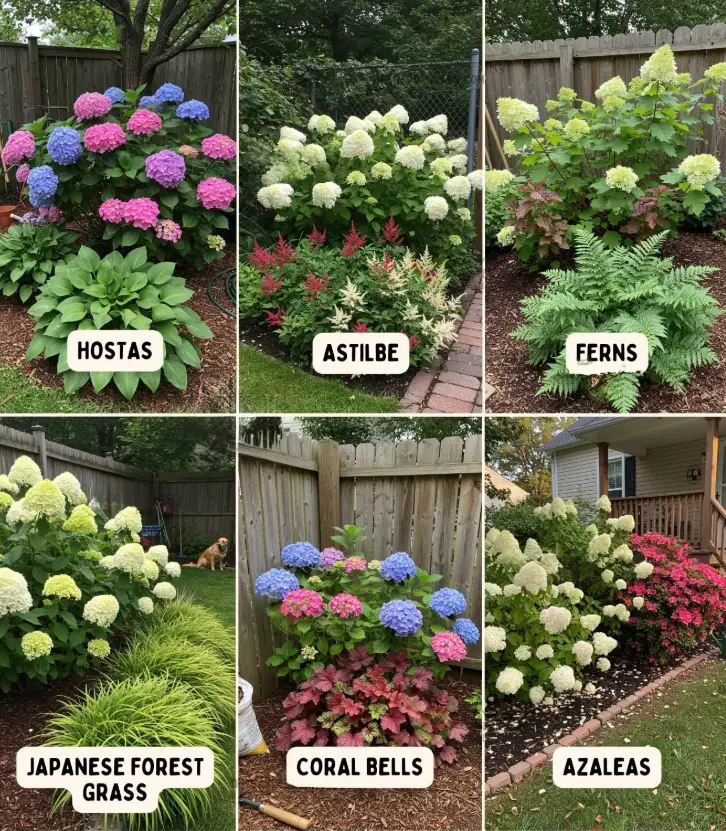Boosting Beauty and Garden Health
Hydrangeas are renowned for their lush blooms and vibrant hues, but their true potential is fully realized when paired with companion plants that enhance their visual appeal and thrive under similar growing conditions. Whether you’re aiming for a cool, moist woodland look or a bold, colorful statement in partial shade, choosing the right companions ensures that your garden thrives in harmony.
🌿 Why Companion Planting Matters for Hydrangeas
Companion planting is more than just an aesthetic decision. It plays a crucial role in promoting plant health, soil moisture retention, and disease resistance. By selecting plants that prefer the same light and moisture conditions as hydrangeas, we create a self-sustaining ecosystem that looks stunning and performs efficiently.
💚 Hostas – The Shade Garden Workhorse
Hostas are a classic choice for pairing with hydrangeas. Their broad, textured foliage offers a beautiful contrast to the rounded clusters of hydrangea blooms, while thriving in the same partial to full shade environments.
- Moisture Needs: High – just like hydrangeas
- Light Requirements: Dappled shade to full shade
- Best Features: Variegated leaves, excellent ground cover, deer-resistant varieties available
Hostas help to fill in garden beds, reducing the need for mulch and helping to retain soil moisture, which is vital for hydrangea health.
❤️ Astilbe – A Feathery Blooming Counterpart
Astilbe offers feathery, plume-like blooms that add vertical interest and a touch of elegance beneath hydrangeas. It flourishes in the same cool, moist conditions, making it a seamless match.
- Color Range: Pinks, reds, whites, and purples
- Height: Ranges from 12″ to 36″, depending on variety
- Bloom Time: Early to midsummer – complements hydrangea bloom cycles
Their finely cut foliage and upright flowers bring textural contrast, especially effective when placed in groups around hydrangeas.
🌿 Ferns – Texture and Elegance in the Shade
For those seeking a lush, woodland aesthetic, ferns are indispensable. Their airy fronds soften the space around hydrangeas, creating a naturalistic, calming effect.
- Light Tolerance: Partial to full shade
- Soil Needs: Rich, organic, consistently moist
- Key Varieties: Japanese Painted Fern, Lady Fern, Ostrich Fern
Ferns are not only beautiful but also low-maintenance and pest-resistant, making them ideal for busy gardeners who want a cohesive, low-effort landscape.
💛 Japanese Forest Grass (Hakonechloa) – Flowing Contrast and Color
Japanese Forest Grass brings movement and color to hydrangea beds. Its graceful, arching foliage introduces a golden-green hue that contrasts wonderfully with the deep greens and colorful hydrangea blooms.
- Growth Habit: Mounding and spreading – ideal for border planting
- Light Conditions: Best in partial shade
- Water Needs: Medium – similar to hydrangeas
The dynamic texture of Hakonechloa helps to soften hard lines, making it perfect for designing flowing garden paths or bed edges.
🧡 Coral Bells (Heuchera) – Rich Color and Compact Growth
Coral Bells are prized for their vibrant foliage, ranging from deep burgundy to lime green. Their compact size makes them perfect underplantings for larger hydrangea shrubs.
- Key Advantage: Year-round color in foliage
- Preferred Conditions: Shade to partial sun, moist well-drained soil
- Bonus: Attracts pollinators with tiny bell-shaped flowers
Use Heuchera to add pops of color and create depth in layered shade gardens alongside your hydrangeas.
🌺 Azaleas – Bloom Powerhouse with Matching Needs
Azaleas share many of the same cultural needs as hydrangeas, such as acidic soil, ample moisture, and shade tolerance. When grouped together, they create a show-stopping bloom display from spring through summer.
- Height Range: 2 to 6 feet, depending on variety
- Best Conditions: Morning sun with afternoon shade
- Soil Preference: Acidic, well-drained, rich in organic matter
Azaleas not only mirror hydrangeas in care but also complement them in bloom timing and intensity, turning any shady corner into a riot of color.
🌱 Tips for Successful Shade Garden Design
Designing a thriving shade garden isn’t just about picking the right plants—it’s about ensuring they coexist harmoniously. Follow these tips for optimal results:
- Group plants with similar needs: All companions listed above love moist, well-drained soil and partial shade.
- Use mulch generously: It retains soil moisture and keeps roots cool.
- Layer heights: Place taller hydrangeas at the back, medium-height plants like astilbe in the middle, and ground-level varieties like hostas and coral bells in front.
- Consider color and texture: Blend fine textures (ferns, astilbe) with bold leaves (hostas, Heuchera) for balance.
- Stagger bloom times: Pair early bloomers with summer and fall-flowering species for continuous interest.
🌼 Bonus Planting Ideas to Enhance Hydrangeas
To take your garden to the next level, consider these additional companions:
- Lungwort (Pulmonaria): Spring-blooming, spotted leaves offer interest even after flowering.
- Brunnera (False Forget-Me-Not): Adds sky-blue flowers in early spring and bold foliage all season.
- Bleeding Heart (Dicentra): Arching stems with heart-shaped blooms add elegance and grace.
These subtle additions offer seasonal diversity and foliage texture, perfect for expanding your shade garden palette.
📌 Final Thoughts: A Cohesive, Moisture-Loving Shade Garden
By choosing the right plant partners for hydrangeas, you not only enhance their beauty but also create a resilient, thriving garden that requires less intervention. Hydrangeas serve as a majestic anchor plant—elevate them further with companions that celebrate their natural elegance and enjoy the same cool, moist conditions.
With thoughtful planning, your shade garden will not only survive—but shine.

